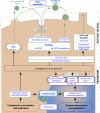The ins and outs of eukaryotic viruses: Knowledge base and ontology of a viral infection
- PMID: 28207819
- PMCID: PMC5313201
- DOI: 10.1371/journal.pone.0171746
The ins and outs of eukaryotic viruses: Knowledge base and ontology of a viral infection
Abstract
Viruses are genetically diverse, infect a wide range of tissues and host cells and follow unique processes for replicating themselves. All these processes were investigated and indexed in ViralZone knowledge base. To facilitate standardizing data, a simple ontology of viral life-cycle terms was developed to provide a common vocabulary for annotating data sets. New terminology was developed to address unique viral replication cycle processes, and existing terminology was modified and adapted. The virus life-cycle is classically described by schematic pictures. Using this ontology, it can be represented by a combination of successive terms: "entry", "latency", "transcription", "replication" and "exit". Each of these parts is broken down into discrete steps. For example Zika virus "entry" is broken down in successive steps: "Attachment", "Apoptotic mimicry", "Viral endocytosis/ macropinocytosis", "Fusion with host endosomal membrane", "Viral factory". To demonstrate the utility of a standard ontology for virus biology, this work was completed by annotating virus data in the ViralZone, UniProtKB and Gene Ontology databases.
Conflict of interest statement
Figures




Similar articles
-
Bacterial Virus Ontology; Coordinating across Databases.Viruses. 2017 May 23;9(6):126. doi: 10.3390/v9060126. Viruses. 2017. PMID: 28545254 Free PMC article.
-
Home treatment for mental health problems: a systematic review.Health Technol Assess. 2001;5(15):1-139. doi: 10.3310/hta5150. Health Technol Assess. 2001. PMID: 11532236
-
The clinical effectiveness and cost-effectiveness of enzyme replacement therapy for Gaucher's disease: a systematic review.Health Technol Assess. 2006 Jul;10(24):iii-iv, ix-136. doi: 10.3310/hta10240. Health Technol Assess. 2006. PMID: 16796930
-
Topotecan, pegylated liposomal doxorubicin hydrochloride and paclitaxel for second-line or subsequent treatment of advanced ovarian cancer: a systematic review and economic evaluation.Health Technol Assess. 2006 Mar;10(9):1-132. iii-iv. doi: 10.3310/hta10090. Health Technol Assess. 2006. PMID: 16545208
-
A rapid and systematic review of the clinical effectiveness and cost-effectiveness of paclitaxel, docetaxel, gemcitabine and vinorelbine in non-small-cell lung cancer.Health Technol Assess. 2001;5(32):1-195. doi: 10.3310/hta5320. Health Technol Assess. 2001. PMID: 12065068
Cited by
-
Resources to Discover and Use Short Linear Motifs in Viral Proteins.Trends Biotechnol. 2020 Jan;38(1):113-127. doi: 10.1016/j.tibtech.2019.07.004. Epub 2019 Aug 16. Trends Biotechnol. 2020. PMID: 31427097 Free PMC article. Review.
-
In vitro methods for testing antiviral drugs.Biotechnol Adv. 2018 May-Jun;36(3):557-576. doi: 10.1016/j.biotechadv.2017.12.016. Epub 2017 Dec 29. Biotechnol Adv. 2018. PMID: 29292156 Free PMC article. Review.
-
Bacteriophage-Mediated Cancer Gene Therapy.Int J Mol Sci. 2022 Nov 17;23(22):14245. doi: 10.3390/ijms232214245. Int J Mol Sci. 2022. PMID: 36430720 Free PMC article. Review.
-
A metagenomic study of gut viral markers in amyloid-positive Alzheimer's disease patients.Alzheimers Res Ther. 2023 Aug 22;15(1):141. doi: 10.1186/s13195-023-01285-8. Alzheimers Res Ther. 2023. PMID: 37608325 Free PMC article.
-
Coordinating virus research: The Virus Infectious Disease Ontology.PLoS One. 2024 Jan 18;19(1):e0285093. doi: 10.1371/journal.pone.0285093. eCollection 2024. PLoS One. 2024. PMID: 38236918 Free PMC article.
References
MeSH terms
Grants and funding
LinkOut - more resources
Full Text Sources
Other Literature Sources
Medical

